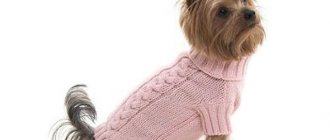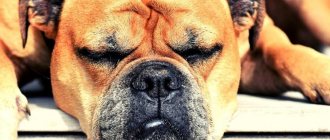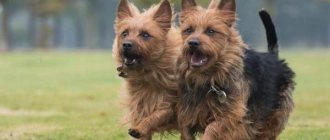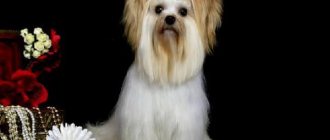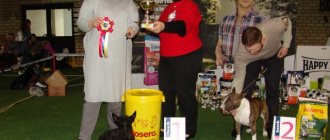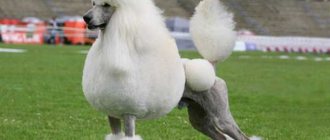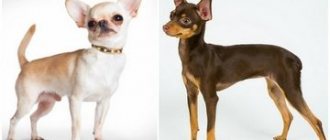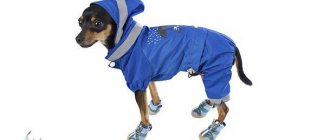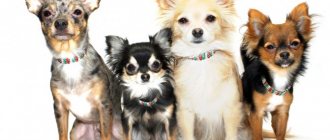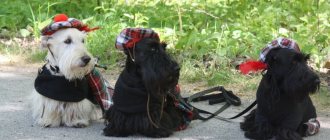Currently, the Yorkshire Terrier is especially popular and loved.
These noble pets are easy to care for, do not have problems with their fur, but they have a mischievous character and are very obedient.
The huge demand for this breed has led to the fact that, as a result of long-term genetic modifications, many new subspecies have appeared, which have many similarities with the standard, but also differ from them in many ways.
What types of Yorkshire terriers are there? We will talk about this in this article, and also show photos with examples.
Non-standard Yorkie colors
For many subspecies of standard Yorkies, the classic color is officially recognized by the FCI and the American Kennel Club (AKC). This breed was approved in the 1970s.
Initially, dogs were not considered decorative. Terriers were used to catch rodents, as Yorkies did not get along well with mice and rats.
Dogs that differ from the recognized colors are not allowed to participate in exhibitions and competitions. However, Yorkies can make excellent companions. If a client chooses dogs in a showroom for show life, he should refrain from purchasing specimens of the following colors.
- White and black terrier. As a result of a mutation in the gene that is responsible for color in Germany, black terriers with white fur were born. In 1988, a rare type of Yorkie was first introduced to the world, and was officially approved as a separate breed only in 2007. A standard was established for terriers, according to which white wool should be combined with colors:
- on the head - with a blue or golden sheen;
- on the body - with a black tint.
These individuals have good health and are not susceptible to diseases that standard terriers experience.
- The Biro Yorkie is not considered a separate breed like the Biewer Yorkie. These dogs completely lack the gene responsible for black fur. Most often these are individuals of chocolate-white and golden color. The subspecies appeared not so long ago; the Yorkie size standard has not yet been established.
- Chocolate York (Choco-York) - dog experts do not recognize the breed as ideal. Almost all of the terrier's fur is brown, shades from milk chocolate to dark bitter. The only condition is that the Yorkie's color is evenly distributed.
- Golden York (Goldusty) - found in all sorts of golden, caramel shades. Sometimes there are individuals with a white breast. Dogs with light colors may be confused with Biewers.
- Yorkie - Mermaid - a mixture of terrier with other species. They are otherwise called salon dogs. However, the appearance is very similar to Yorkies. Most often these are dogs with golden, red, and silver colors. There are individuals with white chocolate-colored fur. The coat of such terriers feels much harsher than that of the classics. Mermaids are larger in size than other dogs.
There are several more subspecies of terriers: mini-, micro-, baby Yorkies. They differ from the classic breed in size.
Beaver
A well-known dog, which we often see on TV screens together with stars. Beaver has a wayward character, but an incredibly cute appearance. The dog's weight is 2-3 kg, and the average height is 22 cm. The color of the head is black and white with gold.
The Yorkshire Biewer Terrier will easily become your excellent friend, since from a young age it can understand the owner’s mood. As an adult dog, they are completely non-aggressive and get along well with small children. Not surprising, because the dog is very playful and loves attention. It lends itself well to training, taking into account a good relationship with the owner.
This type of Yorkie was bred more as a four-legged friend than as a servant, so it is advisable to take him to exhibitions. You can also please your four-legged friend with grooming and various haircuts. The following photo shows a Biewer Yorkshire Terrier.
The only downside may be the constant need for brushing. If you are not eager to make an exhibition piece out of your dog, the problem can be solved. To do this, it is enough to cut the puppy's hair as short as possible. For a description of the breed and characteristics of Biewer Yorkies, see the following video.
Recognized Yorkie colors
There is only one color of terriers allowed for exhibitions - classic.
Standard:
- The fur on a Yorkie's face should not be white, black or brown. Colors allowed: golden, dark red
- The terrier's head is small, proportionally small in comparison with the body. The nose is round and black. The eyes are not protruding.
- The ears are erect, triangular in shape, and small in size.
- The structure of the coat is straight, smooth, and silky to the touch. It is long on all parts of the Yorkie's body, flowing down.
- The collar is a similar shade as the muzzle - dark red, golden brown.
- The body and tail are exclusively with a blue steel tint.
This is interesting: DIY clothes for Yorkies
The presence of white, gray or black hairs on the body of a Yorkie is considered a flaw. The tail can be either the same shade as the fur or darker, but always with a blue tint. It also happens that the roots are darker than the tips. This is not considered a deviation.
The weight of dogs ranges between 2000-3100 g. Dogs weighing 1.5-2 kg belong to the subspecies of York Terriers - mini-Yorks. Less than this value are micro-Yorks.
Changes with age
Age-related changes in color are not associated with recoloring, but with the fact that the structure of a dog’s coat changes with age: the hairs become thinner and the pigment granules in them are not so close to each other, as a result of which Yorkshire terriers become lighter and have a dark steel-colored coat. cover is replaced by bluish-silver.
At the same time, the intensity of the golden-brown color in certain areas remains unchanged, since the granules containing this pigment are much smaller than the granules of the dark pigment, due to which they are able to freely penetrate the hairs and be located in them as tightly as before, even after how they became thinner.
What color to choose a puppy
In order not to make a mistake when choosing a Yorkie puppy that meets the standards, first of all, you need to check all the relevant documents:
- certificates from exhibitions, if any;
- complete information about the puppy's pedigree;
- certificates from the veterinary clinic with all vaccinations.
Responsible breeders are required to provide a package with these documents. If they refuse to show them or say that there are no papers, you should think about the integrity of such a seller.
It is recommended to pay attention to the conditions in which puppies grow up:
- It is worth avoiding houses where dogs are kept outside (Yorkies have poor health).
- There must be order in a shelter or nursery.
- Puppies are characterized by playfulness and liveliness, so it is advisable to look at their behavior: they should be active.
Newborn puppies slightly resemble Rottweilers. They are completely black except for small brown spots on the face. Dogs will be dark for up to 2 months, then they will begin to lighten. This is due to hormonal changes.
You can buy a puppy 4-6 months old; usually at this age it is already clear what color the mature dog will acquire. However, it will cost more, and changes can take place up to 2 years of age.
To make sure as much as possible about the future color of the puppy, you need to part the fur on its head and look: if the roots of the hairs turn golden, then, most likely, the dog will take on the correct color.
It is also advisable to pay attention to small details, such as:
- wet black nose (you can use it to determine whether the puppy is healthy);
- shiny eyes, not protruding;
- type of ears (at 3 months they should be standing).
The breeder is obliged to show how to properly trim dogs and how to care for them.
The pet is also examined for the following abnormalities:
- overly curved body;
- incorrect position of the ears;
- short or elongated muzzle;
- malocclusion, jaw problems;
- the tail is below the level of the back;
- light hairs in dark areas and vice versa;
- cryptorchidism.
And of course, it is worth examining your pet for standard deficiencies, such as deafness or blindness, or breathing problems.
Expert opinion
Anna Abramenko
An avid dog lover. Experience in veterinary medicine since 2009.
Ask a Question
Vaccinated terriers with good pedigree cannot be cheap.
Baby face
Baby face (English: “baby face”) is a variety of Yorkies that has the cutest appearance. This species has some differences from the breed standard:
- Round head and short muzzle.
- The ears are located below the level of the forehead.
- Round, large and protruding eyes give the impression that the dog is looking with surprise and curiosity.
Along with their beautiful appearance, Baby Face Yorkies also have disadvantages:
- Predisposition to conjunctivitis due to large eyes and narrowed tear duct.
- Protruding eyes are prone to injury.
- Teeth are small and prone to falling out, which means they require more careful care.
Also, due to their shortened muzzle, these Yorkies snore and make strange sounds while running, but this in no way threatens the life and health of the pet.
Grooming to enhance color
If a dog does not develop a permanent silver color on its back before 10 months and remains black, you should not hope for the appearance of a steel tint. However, prolonged exposure to the sun can cause the fur to burn out and fade.
The unexpected appearance of gray hair in a grown individual does not mean that the Yorkie's colors are taking on the desired color. Instead of entering your pet into competitions, you should immediately contact a veterinarian, as this could be the beginning of a serious illness or a lack of zinc in the body.
This does not mean that the coat does not need to be looked after - Yorkies need constant care. Terriers need frequent bathing and haircuts every 2-3 months.
If the dog does not participate in exhibitions, it is not recommended to keep a long coat, as it can get tangled and dirty. Particularly in need of a short haircut are the belly, tail, back and genitals.
Show dogs are usually not trimmed in the specified places, however, they need more supervision: when walking, you should dress your Yorkie in overalls, and wrap their hair in curlers between shows.
Expert opinion
Anna Abramenko
An avid dog lover. Experience in veterinary medicine since 2009.
Ask a Question
Because of the long locks, debris gets into your Yorkie's eyes. To avoid diseases, the hair from the muzzle is removed in curlers and the eyes are wiped with a clean swab every day.
Features of Yorkshire Terriers
Yorkies are very loyal and brave dogs, attached to their owner. In defense of their owner, they can rush at a dog, even one that is much larger than him in size. They have high intelligence and respond well to various types of training. However, the Yorkie is not a circus dog. They will not “dance to the tune.” These are wayward animals with their own opinions, which will obey only those who can become the leader for the dog.
Important! Raising a pet must be done from early childhood, otherwise the owner runs the risk of getting an uncontrollable, aggressive dog that attacks every living thing.
Yorkshire Terriers get along well in families with children, taking kids for granted. However, they are unlikely to engage in active games with them, fooling around and lying around. These are very balanced and sedate dogs who know their worth.
But the main feature of the breed is still their coat. Long, flowing with an unusual steely tint. The pet is completely devoid of undercoat, so in the cold season they are often dressed up in different warm suits. But in the summer they show themselves in all their glory. If the owner takes good care of his pet's coat, then he always looks like a king.
Conclusion
Before you decide to get a Yorkshire Terrier, it is advisable to weigh the pros and cons.
Pros:
- York Terriers are loyal, intelligent creatures. They are active, playful, determined, and do not require daily walking, as they can be trained to use a litter box at home;
- the breed is considered hypoallergenic;
- dogs do not shed and do not have an unpleasant odor.
The disadvantages include:
- need for special care;
- additional expenses for purchasing clothes (shoes are even recommended in winter);
- high price;
- poor health. Terriers are prone to colds and have fragile bones.
The owners note that these dogs make excellent household members. They get along well with other animals and do not take up much space. Sometimes Yorkies can be capricious, but they have a good-natured character.
Briefly about the history of the breed
Representatives of this breed come from England, where they were bred back in the 18th century. And although there is no documentary evidence about the origin of Yorkshire terriers, many are of the opinion that the ancestors of dogs can be considered ancient terrier-like rat catchers.
Small dogs were bred specifically to protect plantations from moles, rodents and other crop pests. The peasants brought them on purpose, thus circumventing the law on poaching, according to which it was forbidden to have large animals.
According to another opinion of scientists, this rock helped miners in searching for underground gas. Then workers were not allowed to take pets with them into the depths. But such miniature animals easily fit under clothes and quietly followed their owners.
There is a version that Yorkshires appeared much earlier. Similar doubts arose after studying the records of the Roman naturalist Pliny the Elder in the 1st century AD, which mention small dogs discovered in the British Isles. Archaeologists believe that the history of this breed begins precisely from this territory, from where sailors took them to other countries.
Already in 1605, King James VI of Scotland (I of England) described in his writings Scottish burrow dogs, which in appearance are very similar to the current Yorkies. Therefore, the counties of Yorkshire and Lancashire, located in northern England, are considered to be the homeland of the Yorkshire Terrier.
Useful video
We recommend that you familiarize yourself with the video and photos to clearly recognize and see the lovely Yorkshire terriers.
Métis
Mixed breeds are puppies born as a result of crossing two purebred dogs of different breeds or a purebred dog and a mongrel. For a long time, Yorkshire terriers have been crossed with representatives of other breeds, resulting in simple mestizos or designer dogs. In addition to Chorkies obtained as a result of mating with Chihuahuas, the following are used for crossing with Yorkshire Terriers:
- Shih Tzu.
- Pekingese.
- Maltese dogs.
- Shpitsev.
- Toy - terriers.
Morkies or Yorkies
This is the name given to designer puppies born from crossing Yorkies and Maltese dogs. These are persistent and hardy dogs, very loyal and affectionate. They have a long, straight and silky coat, with a color similar to that of Yorkshire Terriers.
They are difficult to train due to their innate stubbornness, so it is necessary to start training from a very early age. Among the disadvantages of the Morka, there is a tendency to early loss of teeth, so it is necessary to regularly check the condition of the pet’s oral cavity.
Shorkie
This name is given to mixed breeds of Yorkshire Terrier and Shih Tzu. These dogs have a Shih Tzu-like build, small size and a wide but cute muzzle. Their coloration is usually the same as that of Yorkies, but some individuals have spots of different colors.
Torquay
The appearance of Toy Terrier and Yorkie mixes is very ambiguous: puppies can be cute or not so cute. Dogs are rarely large in size, because they are born from two small breeds, the hair is of medium length, and the limbs are not too thin.
Yorkines
Mixed breeds of Yorkies and Pekingese are not characterized by good health. In addition, it is with such crossing that puppies do not always take the best qualities of their parents; there are individuals with an undesirable set of characteristics. This becomes the cause of bad fur, squinting eyes, an unformed skull, a non-overgrown fontanel and other problems.
Yorkies and Spitz
Crossing two charming breeds produces equally charming puppies with good health. In addition to their external characteristics, puppies adopt the best character traits from Yorkies and Spitz dogs - these dogs are very kind, gentle, active and devoted to their owner.
As a rule, these mestizos grow to small sizes in adulthood, less often to medium ones. Otherwise, their appearance is unpredictable: the length, structure, coat color and body format can be anything. Each puppy born from the mating of a Yorkie and a Spitz has unique characteristics.
Sometimes breeders also breed Yorkshire Terriers with Poodles or Shelties.

